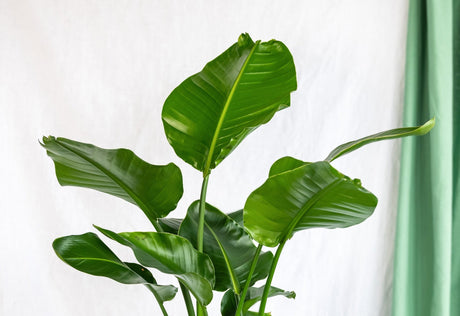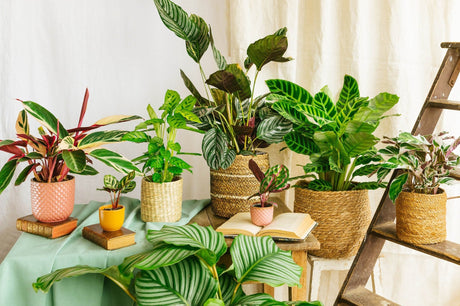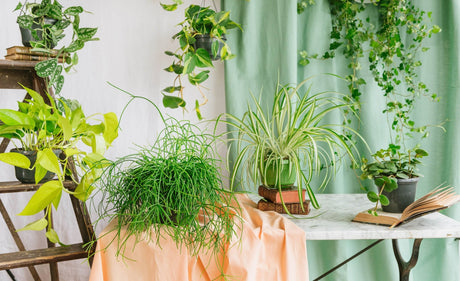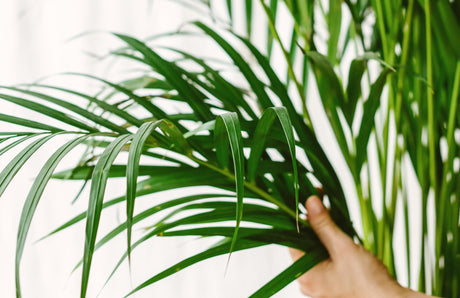Native of the tropical forests of South America, this plant has distinctive leaves, marbled of white cream, which make it a real eye-catcher.
The Philodendron Birkin is distinguished by its unique characteristics:
- Marbled leaves: The leaves of the Birkin are adorned with splendid white marbled patterns, evoking a natural elegance.
- Compact Growth: This plant grows relatively compact, making it perfect for small indoor spaces.
- Adaptability: Philodendron Birkin adapts well to indoor conditions, making it a popular choice for indoor gardens.
1. Watering the Philodendron Birkin
The Philodendron Birkin prefers that the soil partially dry out between waterings. Avoid excess moisture, as this may lead to root rot problems. In general, watering every 1 to 2 weeks is often sufficient, but this can vary depending on the conditions environmental.
Tip : Iinsert your finger into the ground to approximately 2-3 centimeters depth. If the soil is dry at this level, it is time to water.Avoid overwatering, as the roots of Philodendron Birkin are susceptible to rot .
2. Watering techniques
Watering from above
This is the most common watering method. Gently pour water at the base of the plant until excess water begins to flow out of the drainage holes in the pot. Be sure not to overwater, as consistently soggy soil can lead to root rot issues.Watering by soaking
This method involves completely immersing the pot of the Philodendron Birkin in water for a few minutes. Let the pot drain before placing it back in its saucer orWatering from below
Place the pot of the Philodendron Birkin in a shallow saucer filled with water. The plant will absorb water by capillary action through the drainage holes. Be careful not to leave the plant in standing water for an extended period of time, as this can also cause root rot issues.3. The Exhibition of Philodendron Birkin
The Philodendron Birkin thrives in bright indirect light. Avoid direct sun exposure, as this may cause burns on the delicate leaves. Place your plant near a window with brightness bright, but dim by light curtains or blinds.
Si possible, place the Philodendron Birkin near a window facing east or west. This will provide the adequate amount of light without exposure direct to sun intense from noon.
In case of low brightness natural, you can supplement lighting with sources of light artificial. The lamps of growth or the bulbs LED especially designed for Houseplants can help maintain the health of your Philodendron Birkin.
4. When should I repot my Philodendron Birkin ?
The repotting of the Philodendron Birkin is a step crucial to maintain its growth healthy and its development optimal.The Philodendron Birkin needs repotting every 1 to 2 years, usually in spring or beginning of summer. However, watch for signs specific of overgrowth or need more space to determine if your Birkin needs to be repotted sooner.
The signs of a need of repotting:
Root crowding
If your Philodendron Birkin's roots are starting to stick out of the pot's drainage holes, or if they're forming a dense tangle on the surface of the soil, it's time to repot.Slowed growth
If your plant stops growing as quickly as it used to, or if new leaves are smaller and less healthy, it could be a sign that it's running out of space for its roots.Watering frequency
If you find you need to water more frequently than usual because the soil dries out quickly, it may be a sign that the roots have filled the current pot.Soil depletion
If the soil in your pot has become compacted, depleted, or no longer provides good aeration, repotting may be necessary to provide fresh nutrients and promote root health.5. What fertilizer should I use for my Philodendron Birkin ?
It is recommended to use a fertilizer specifically formulated for green plants. interior with green leaves.Application frequency
In general, it is recommended that you fertilize your Philodendron Birkin approximately every 4-6 weeks during the period of active growth, which is usually in the spring and summer. Reduce the frequency in fall and winter when the plant enters a slower growth phase.Dosage
Follow the instructions on the fertilizer package to determine the correct amount to use. Avoid over-fertilizing, as this can cause salts to build up in the soil and harm the health of the plant.Watering after application
After applying the fertilizer, water your Philodendron Birkin lightly to help distribute the nutrients throughout the soil.6. How do I multiply my Philodendron Birkin ?
The multiplication of Philodendron Birkin can be achieved by cutting.Choose a healthy stem of the Philodendron Birkin that has at least two nodes ( points where the leaves are attached to the stem). Cut the stem just below a knot with a clean knife or scissors. Make sure that the cutting is approximately 5 to 10 cm long. Remove the leaves from the node lower of the cutting.
Insert the cutting into the potting soil prepared so so that the lower node is buried in the ground. Press gently to compact the soil around the cutting. Moisten slightly the soil around the cutting. Place the cutting in a bright place but indirect. Avoid direct sunlight which could burn the cutting.
7. Diseases of Philodendron Birkin
The Philodendron Birkin is usually a plant hardy, but like all plants it can be prone to certain diseases or problems. Here are some diseases and problems common that your Philodendron Birkin might be confronted:Root rot
Overwatering or constantly soggy soil can lead to root rot. Signs include wilting, yellowing leaves and soft roots. To prevent this, make sure the pot has good drainage and only water when the soil is slightly dry. If root rot is suspected, remove the plant from the pot, cut off the affected parts and replant it in well-drained soil.Leaf spots
Brown, black or yellow spots on the leaves can be caused by problems with humidity, water on the leaves, insects or diseases. Avoid watering the leaves directly, and if the spots spread, remove the affected leaves and adjust the growing conditions.Oidium
Powdery mildew is a fungal disease that can appear as a white powder on the leaves. It often thrives in humid conditions. To prevent powdery mildew, maintain good air circulation and avoid excess humidity.Mealybugs, aphids and mites
These pests can infest the Philodendron Birkin, causing leaf damage. Inspect your plants regularly and treat infestations with natural or chemical insecticide solutions if necessary.Yellowing of leaves
A general yellowing of the leaves can be due to watering problems (too much or not enough), a lack of nutrients, or unsuitable environmental conditions. Adjust care accordingly, taking into account watering, fertilizing and light exposure.Nutrient deficiencies
Leaves that are pale, discolored, or have unusual patterns can indicate nutrient deficiencies. Use a balanced fertilizer and follow the recommendations to avoid deficiencies.8. Delivery and receipt of your plant
- Your plant is dry
- Is your plant wet ? Let the potting soil dry.
- Should I repot my plant right away ? No ! Wait until next spring or for signs that your plant needs repotting.






